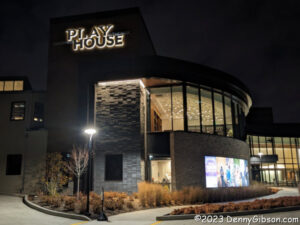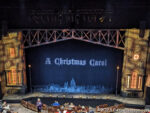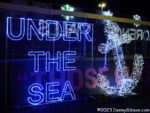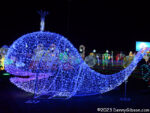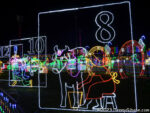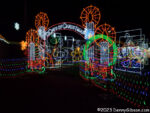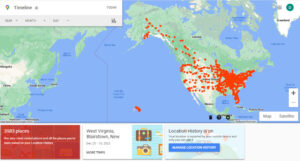 My parents would be absolutely appalled to see something like this. It’s my Google Maps Timeline which I was reminded of in an email about a week ago. Seeing a record of their travels that they did not create would have truly alarmed my parents. They, and most of their generation, guarded their privacy to the nth degree. Subsequent generations, including mine, have each been a little less guarded than the one before. In at least one regard, I am less protective of my privacy than many of my own generation. That, of course, would be travel. A guy with a website that exists primarily to tell people about his road trips is obviously not going to be upset that somebody knows about them. I’m much more likely to be upset that more people don’t.
My parents would be absolutely appalled to see something like this. It’s my Google Maps Timeline which I was reminded of in an email about a week ago. Seeing a record of their travels that they did not create would have truly alarmed my parents. They, and most of their generation, guarded their privacy to the nth degree. Subsequent generations, including mine, have each been a little less guarded than the one before. In at least one regard, I am less protective of my privacy than many of my own generation. That, of course, would be travel. A guy with a website that exists primarily to tell people about his road trips is obviously not going to be upset that somebody knows about them. I’m much more likely to be upset that more people don’t.
For any that are appalled or upset or even a little uncomfortable, please note that maintaining the timeline is enabled by a Google account setting called Location History. The email that reminded me of its existence also reminded me that I “can view, edit, and delete this data anytime in Timeline.” I cannot speak to how well disabling the feature or deleting the data works because I’m not interested in either.
The map above includes all data from when Google Maps started watching me sometime in 2014. A drop-down list goes back to 2010 but 2014 seems to be the first year with any data recorded. There are also drop-downs for month and day for drilling down to some details.


 Here are the maps for all of 2014, the month of December, and Christmas Eve when I drove from Augusta, GA, to Savannah, GA. At the day level, the route and most stops are shown.
Here are the maps for all of 2014, the month of December, and Christmas Eve when I drove from Augusta, GA, to Savannah, GA. At the day level, the route and most stops are shown.
 This post was triggered by that Google Maps reminder email, of course, but also by the fact that this blog’s 2023 in the Rear View post was fresh in my mind. There is another view of 2023 at the right.
This post was triggered by that Google Maps reminder email, of course, but also by the fact that this blog’s 2023 in the Rear View post was fresh in my mind. There is another view of 2023 at the right.
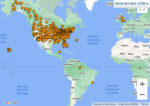 Clearly, all of my travel that Google Maps knows about (i.e., mid-2014 and later) was in North America. To be honest, that’s also true of nearly all of my travel before that but there were a few exceptions. Tripadvisor is a service I joined in 2005. It provides a map of contributions and also allows direct entry of locations for the map. I’m including the Tripadvisor map for an even bigger look in the rear view. Some of the stuff on that map is from the last century.
Clearly, all of my travel that Google Maps knows about (i.e., mid-2014 and later) was in North America. To be honest, that’s also true of nearly all of my travel before that but there were a few exceptions. Tripadvisor is a service I joined in 2005. It provides a map of contributions and also allows direct entry of locations for the map. I’m including the Tripadvisor map for an even bigger look in the rear view. Some of the stuff on that map is from the last century.
 I had this post completed and scheduled when an online discussion reminded me of yet another view of my travels. The image at right is my current map of U.S. counties visited from the MobRule website. I included the May 1, 2017 version in the book published after I visited my 50th state (“50 @ 70“). The current count is 1887 of 3144 or 60%. I failed to record those details about the 2017 map so cannot quantify travels since then but I think the only readily noticeable change between the two maps is a few more shaded areas in the northwest. As I said in 2017, maps like these are extremely misleading in terms of territory covered. Visiting New York County in New York State (the smallest on the mainland) let me shade in less than 23 square miles of area. I got to shade in just under 145,900 square miles when I visited Yukon-Koyukuk County in Alaska.
I had this post completed and scheduled when an online discussion reminded me of yet another view of my travels. The image at right is my current map of U.S. counties visited from the MobRule website. I included the May 1, 2017 version in the book published after I visited my 50th state (“50 @ 70“). The current count is 1887 of 3144 or 60%. I failed to record those details about the 2017 map so cannot quantify travels since then but I think the only readily noticeable change between the two maps is a few more shaded areas in the northwest. As I said in 2017, maps like these are extremely misleading in terms of territory covered. Visiting New York County in New York State (the smallest on the mainland) let me shade in less than 23 square miles of area. I got to shade in just under 145,900 square miles when I visited Yukon-Koyukuk County in Alaska.
 MobRule also supports tracking county equivalents in Canada, Mexico, Great Britain, and U.S. Territories. The only one of these I use is Canada where I have accumulated just 62 of 669 or 8.5%. Overlaying these counts on Google Maps is supported but zooming seems to lose the data. Open Street Map is also supported and does not have this problem. The map at left is from Open Street View.
MobRule also supports tracking county equivalents in Canada, Mexico, Great Britain, and U.S. Territories. The only one of these I use is Canada where I have accumulated just 62 of 669 or 8.5%. Overlaying these counts on Google Maps is supported but zooming seems to lose the data. Open Street Map is also supported and does not have this problem. The map at left is from Open Street View.






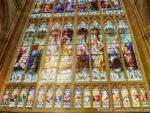








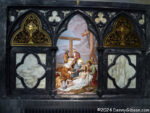

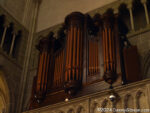
 Everything went up this year. Everything that is except interest. I’ll discuss website traffic toward the end of this post but it’s probably not much of a spoiler to note that it continues its general decline. As for my own activity, I did get in one more trip than last year, and, unlike last year’s added trip, this one did translate to an increase in days on the road and pictures posted. Again, no trips from the year being reviewed made the top five but, unlike 2022 when there were no repeats from the previous year, the first four of 2023’s top five were repeats from 2022 and the fifth sort of was. Two of 2022’s top five blog posts made it again this year along with two brand new posts and one returning after an unusual absence.
Everything went up this year. Everything that is except interest. I’ll discuss website traffic toward the end of this post but it’s probably not much of a spoiler to note that it continues its general decline. As for my own activity, I did get in one more trip than last year, and, unlike last year’s added trip, this one did translate to an increase in days on the road and pictures posted. Again, no trips from the year being reviewed made the top five but, unlike 2022 when there were no repeats from the previous year, the first four of 2023’s top five were repeats from 2022 and the fifth sort of was. Two of 2022’s top five blog posts made it again this year along with two brand new posts and one returning after an unusual absence.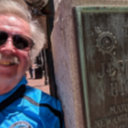

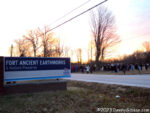
 The year Kevin Patrick spent “connecting with White’s Woods” may have been, as a blurb on the back of Near Woods says “In the spirit of Walden” but the resulting products are not the same. Thoreau’s time at Walden Pond was an experiment in self-sufficiency and the book he wrote some years later documented its success. His observations of nature and seasons were generally used to support some aspect of his minimalist lifestyle and not to educate the reader. I suppose some of Patrick’s observations are also made to reinforce some philosophical viewpoint, but he is a lot more subtle and he helps the reader share the raw observation as near as possible. Exactly one-half of this book’s pages are filled with some excellent photographs.
The year Kevin Patrick spent “connecting with White’s Woods” may have been, as a blurb on the back of Near Woods says “In the spirit of Walden” but the resulting products are not the same. Thoreau’s time at Walden Pond was an experiment in self-sufficiency and the book he wrote some years later documented its success. His observations of nature and seasons were generally used to support some aspect of his minimalist lifestyle and not to educate the reader. I suppose some of Patrick’s observations are also made to reinforce some philosophical viewpoint, but he is a lot more subtle and he helps the reader share the raw observation as near as possible. Exactly one-half of this book’s pages are filled with some excellent photographs.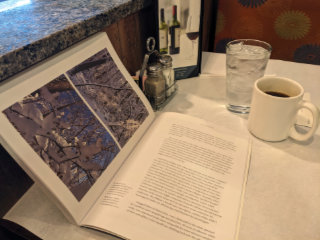 Of course, Near Woods is better looking than either Walden or PrairieErth. To some degree, that’s just something that color photographs do for a book. But these high-quality and well-chosen photos do more than make the book pretty. They are the “raw observations” mentioned in the first paragraph of this article. The book’s design incorporates the photos wonderfully and helps make reading the book a pleasure. Every lefthand page contains one or more photographs. Righthand pages are all text. Captions are in the extra wide inner margins of the text pages. It didn’t take me terribly long to recognize the beauty of this. Every page turn resulted in a new image that could be studied as quickly or slowly as desired before tackling a new page of text.
Of course, Near Woods is better looking than either Walden or PrairieErth. To some degree, that’s just something that color photographs do for a book. But these high-quality and well-chosen photos do more than make the book pretty. They are the “raw observations” mentioned in the first paragraph of this article. The book’s design incorporates the photos wonderfully and helps make reading the book a pleasure. Every lefthand page contains one or more photographs. Righthand pages are all text. Captions are in the extra wide inner margins of the text pages. It didn’t take me terribly long to recognize the beauty of this. Every page turn resulted in a new image that could be studied as quickly or slowly as desired before tackling a new page of text.
